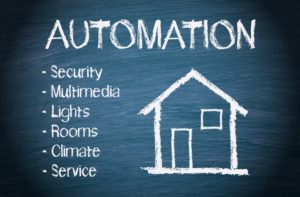Smart home devices and smart home technology is not new to the marketplace. But only recently has it made leaps and bounds into the realm of serious improvement. Gone are the days of installing a few connected appliances or light bulbs. With today’s technology, you can have remote access to any outlet, appliance, light or electronic device in your home.
In 2015, a smart home is so much more than the sum of its parts: it’s a WiFi-enabled, access-from-anywhere, almost-intelligent home that not only keeps you and your family safe, but also ensures you stay comfortable, connected and entertained. It’s finally living up to the moniker, “smart,” with innovative, intelligent features that will wow even the techiest members of the family.
What Is a Smart Home?
First things first, what is a smart home? The Oxford dictionary defines it as, “a home equipped with lighting, heating, and electronic smart home devices that can be controlled remotely by smartphone or computer.”
And they’re right, but that doesn’t tell the whole story. A smart home today is capable of so much more than just flipping the lights or turning up the smart thermostat. Today, you can control every appliance, every electronic, every light and every outlet from your smartphone, anywhere you have a signal. You can program sophisticated presets: automated actions for when you leave for work, get home, or cue date night. You can improve your home’s energy efficiency (and reduce your power bill) by automating your lighting and thermostat based on motion-detection and daily routine. And you can increase the resale value of your home in the process.
Smarter Home Security
But smart homes are about more than convenience and lifestyle: most importantly, they’re about keeping your family safe. Enter the advent of Internet-connected home security camera systems, which are revolutionizing monitored and unmonitored alarm service.
Smart home security monitoring takes many of your traditional alarm accouterments–and new-to-market add-ons–and improves them with Internet connectivity and smartphone access. That means you can monitor and control your system from anywhere, and what’s more, your system also connects with you. So not only can you check on your home, but your system can now notify you, via text, of your preferred emergency and non-emergency triggers, such as a flood sensor going off, your kids arriving home after school, or a visitor ringing your smart doorbell.
And not only that, but you can also manage your security camera system from your phone, tablet or computer. With a swipe of the finger, you’ll activate or deactivate your entire system. You’ll open keyless smart locks if your kids forget their keys. You’ll avert disaster by responding quickly when your carbon monoxide detectors text you an alert. Internet connectivity, cell phones, and sophisticated technologies have opened up a world of possibilities.
Security Companies Are Moving Toward the Internet of Things (IoT)
This world is known as the Internet of Things, and even if you’re unfamiliar with the term, chances are you’ve experienced the technology.
The Internet of Things marries home security systems with WiFi-enabled options, like the above-mentioned smartphone system access, smart locks, or Internet-connected security cameras. It also enables powerful “if this, then that” (IFTTT) recipes, which let you set your own parameters. For example, you can program your smart surveillance to text you a streaming video link if they sense motion; if you determine a prowler’s casing your home, a smartphone swipe will then notify police.
The marriage of smart homes, connected living, sophisticated home security monitoring systems and power mobile technologies is changing the way we live. So hop on board, because it’s going to be a fascinating ride.

